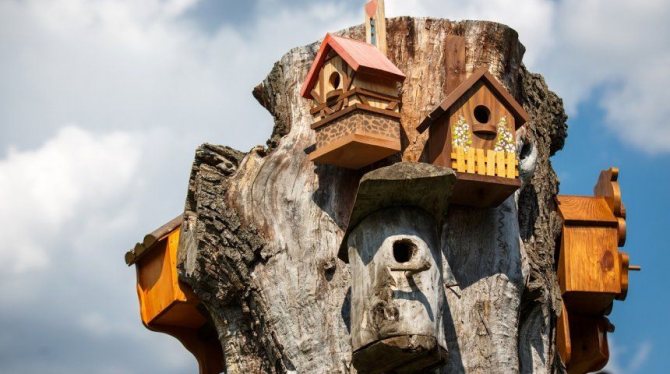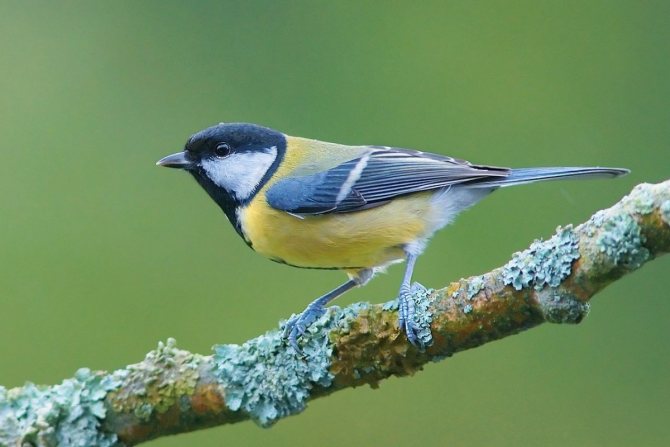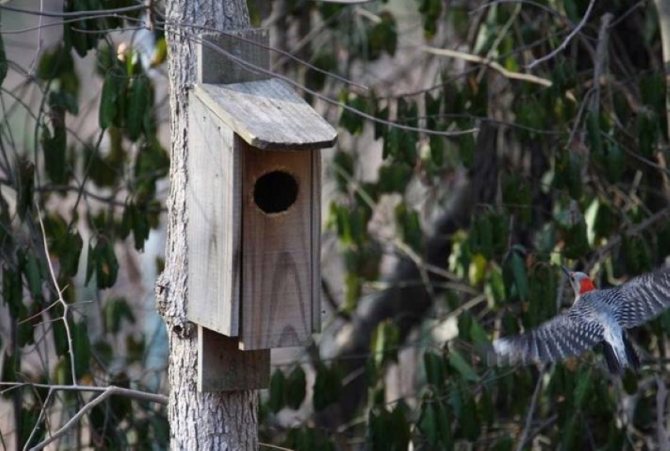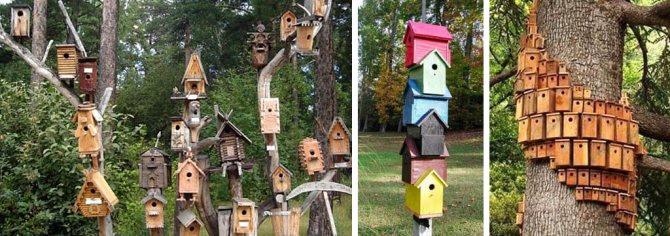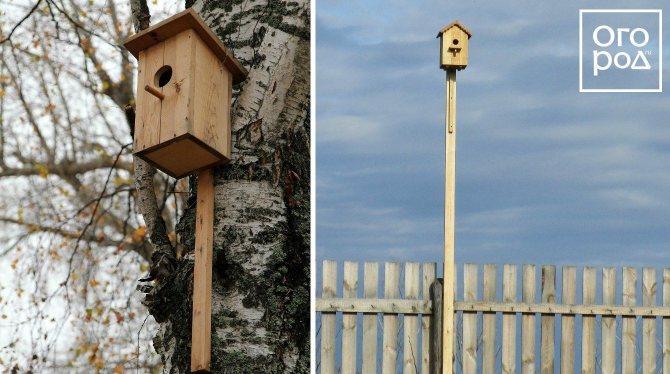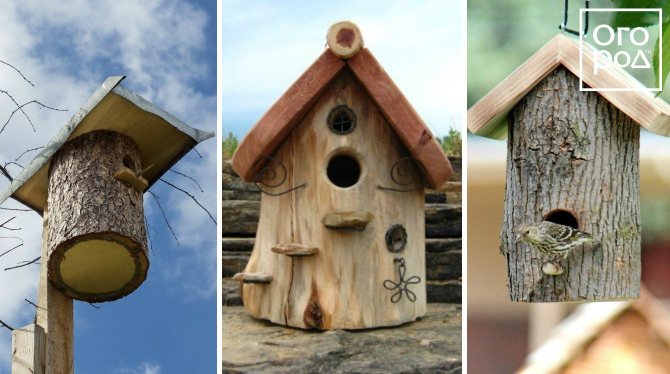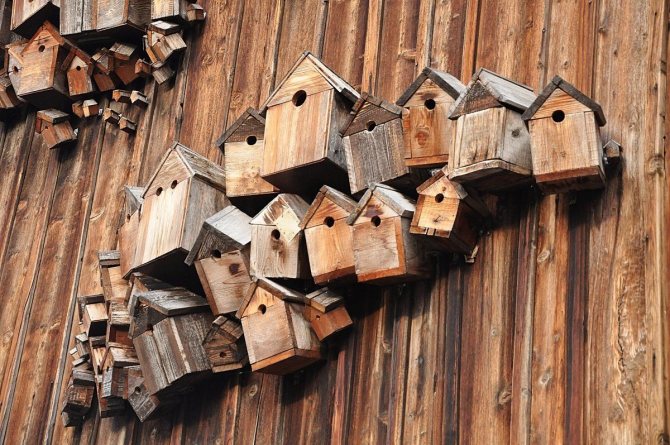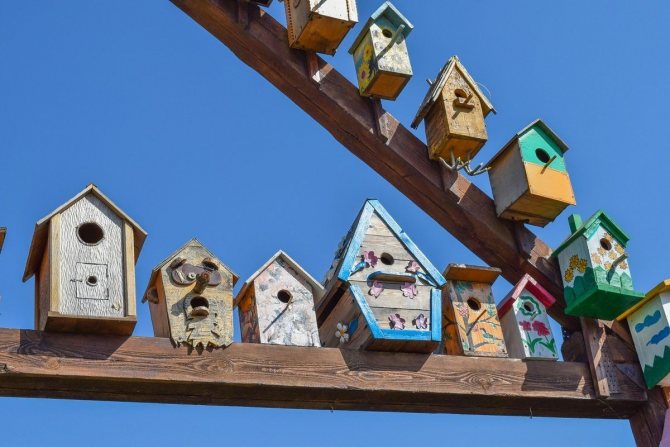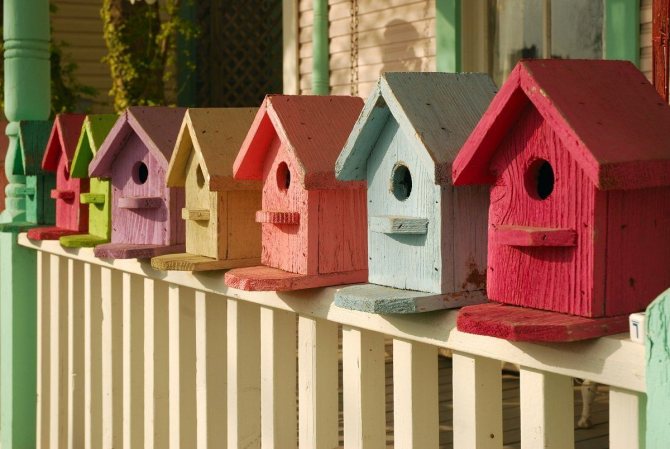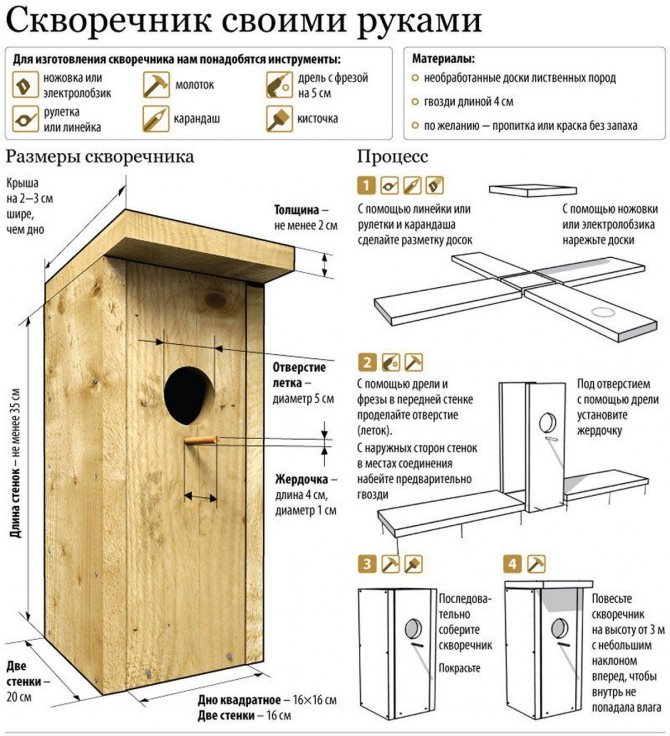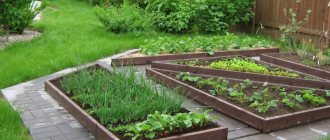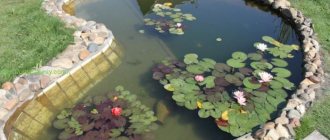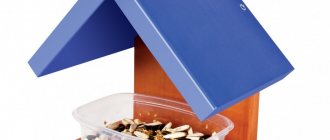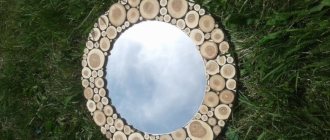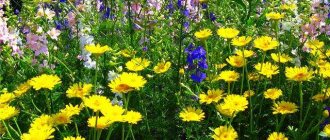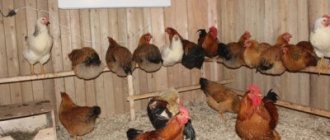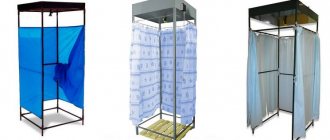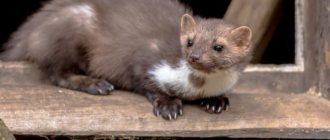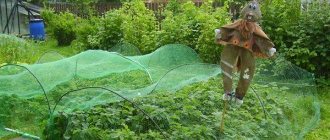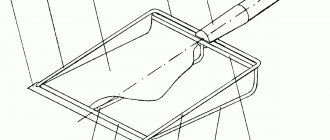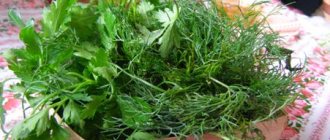How to make a do-it-yourself birdhouse from available materials.
Birds fly from warm countries every spring. It can be difficult for them to find a home: old birdhouses are often destroyed, and trees are felled.
Birds help nature and people. They fight insect pests and their larvae, protect trees. In addition, they make people happy with singing, they give joy. Our task is to take care of them. The simplest thing we can do for them is build birdhouses.
Birdhouses are not just a home for different types of birds, but also an element of decor in the garden and park landscape. You can find birdhouses from a variety of materials and bizarre shapes.
What materials are birdhouses made of:
- The most famous and reliable material is wood;
- Plastic;
- Cardboard;
- Metal;
- Plywood.
Important: The correct bird house is one that is made of wood. Other materials are not suitable for providing a comfortable stay for birds. Birdhouses made of chipboard, cardboard, plastic serve for decorative purposes and are located in places where rain does not penetrate.
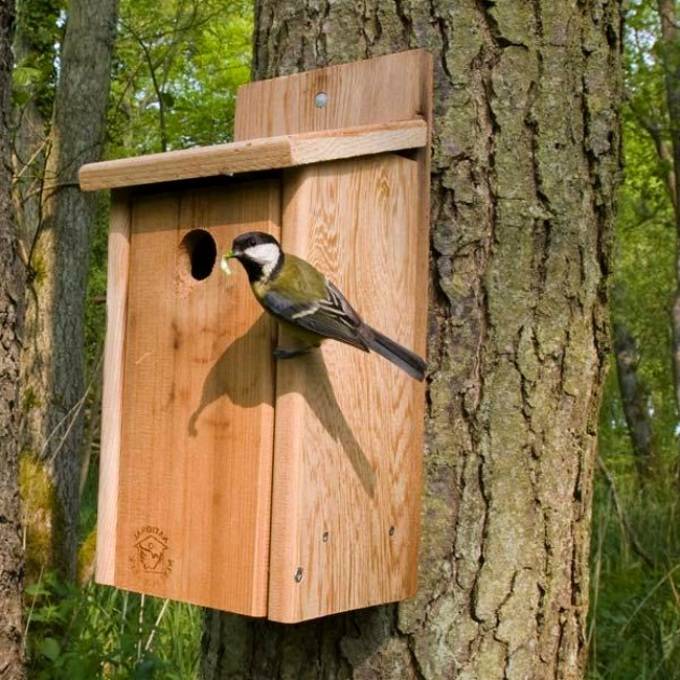
↑ Bird flats
To begin with, artificial bird nests can be built and hung all year round. The fact is that most of our birds manage to feed and put on the wing two or even three broods during the season. Moreover, the same titmouse, for example, will not lay a second clutch of eggs in the same house, but will look for a new apartment. This habit is due to the fact that a mass of parasites (ticks, fleas, etc.) remains in the same place. Those of you who have at least once in your life been attacked by bed bugs at night will quickly understand what this is about. If you care a lot about your birds, then take it as a habit: whenever the last chick left its father's house, remove it, shake out all the contents and thoroughly treat it with boiling water or a solution of potassium permanganate. For the convenience of such disinfection actions, initially plan a removable roof at all artificial nests. By the way, there are more than fifty species in total, which are conventionally combined into a dozen types: open and ground nesting sites, ordinary and combined houses, nest boxes, barrels, sheds, and so on.
Looking ahead, I will explain what "combined houses" mean. The fact is that a birdhouse or a titmouse is just an artificial hollow. Instead of them, you can use an ordinary nest box - a solid piece of round wood with a hollowed out core, but technologically it is quite difficult (you need to have a special tool). However, it is not necessary to make a completely round nest box, it is enough to make it just one side of an ordinary rectangular box. If, instead of a flat front wall, you use a semicircular slab with bark, in which you drill a hole for the inlet, then the birds will prefer such a dwelling first. This is the combined house.
Now the question arises: what diameter should the inlet be? The answer is simple and specific: depending on which of the birds you would like to see inside. If it is a starling, then 4.5-5 cm in diameter, if a tit or a flycatcher, then 3 cm (for small titmouses, it is possible even less - 2.7 cm). An ordinary field sparrow can also settle in the above-described houses. However, do not be discouraged, firstly, this will only happen if the apartment does not suit the titmouse (it is not a big problem for her to drive out the sparrow), and secondly, everything is better than the dumb emptiness of an empty apartment.
Birdhouse sizes and hole diameter for wagtail, titmouse, different birds: table.
Wood is the only natural material that can provide birds with protection from the cold and from rain. Let's not forget that birds are part of nature, and they are not adapted to life in an artificial environment.
What characteristics should a tree have:
- The most suitable types of wood for birdhouses are birch, oak.
- Pine trees are not suitable for this purpose because they release resin.
- The thickness of the boards should be at least 2 cm to keep warm.
- The inside of the birdhouse must be rough so that it is convenient for birds (especially chicks) to get out of the house.
- The boards cannot be fastened with glue, it can emit harmful substances.
- Nails or screws should not stick out of the boards, as birds can get hurt.
Let's talk separately about the size of birdhouses. Birds have different sizes, which means that different species' houses need to be sized appropriately.
Table: Sizes of birdhouses for different birds.
| Bird species | Tap hole diameter (cm) | Bottom width (cm) | Front wall height (cm) | Rear wall height (cm) |
| Titmouse | 3-3,5 | 10-12 (square) | 22-25 | 28-30 |
| Wagtails | 5 | 40 * 15 (rectangle) | 15 | 18 |
| Pikas | 6 | 16-18 (square) | 22-26 | 28-32 |
| Flycatchers | 4 | 10 (square) | 7 | 14 |
Features of bird houses:
- Wagtails will love a house in the form of a rectangle with a threshold in front of the entrance, because this bird loves to stomp before entering the house.
- Pikas settle in birdhouses with two entrances. This helps them to escape if cats attack.
- The flycatcher likes to settle in a half-house - a house that looks like a natural hollow in a tree.
Interior
It is not only the size and shape of the bird nest that are important. It is necessary to take into account the internal illumination, temperature conditions, and the color of the nesting site.
- Pied flycatchers they love the light ones inside the nest, so when the wood darkens in 5–6 years, it is enough to whitewash them inside, and the pestles will again willingly nest in them.
- Titmouse they prefer old houses that are darkened inside, new ones should be painted inside with a stain.
- Most birds more willingly settle down "apartments" painted on the outside in green or the color of the bark of trees.
- Starlings even brightly colored houses can occupy: red, yellow, blue and blue.
How to make a do-it-yourself birdhouse for starlings from wood.
Starling birdhouse size:
- Bottom width - 15 cm;
- Height - 30-40 cm;
- Tap hole diameter - 4-5 cm;
- A round perch in front of the entrance is 5-6 cm long.
Important: On the roof, there must be a small canopy (edge) above the entrance. Then rainwater cannot get inside.
When making birdhouses, you must adhere to the size recommendations. Otherwise, the birds may simply not settle in the house. Starlings can drive out small birds from birdhouses with a large entrance. If you make the entrance diameter too small, the starling may not fit into the hole.
The correct internal space of the birdhouse helps to create favorable conditions for incubating healthy offspring, to create a warm nest. Usually, starlings hatch 5 chicks, rarely the number reaches 7.
To make a birdhouse, you will need the following materials:
- Dry boards;
- Nails or screws;
- Wire (to hang the birdhouse);
- A hammer;
- Hacksaw;
- Drill (d = 50, d = 4 mm);
- Pencil;
- Square;
- Screwdriver, screwdriver.
Important: Every year, birdhouses must be cleaned and watered with boiling water. This simple procedure will help get rid of parasites and prepare your home for a housewarming party.
To quickly clean a birdhouse, you need to make it with a removable roof. At the same time, make sure that the roof holds well and does not fall from the wind or the invasion of "uninvited guests" - cats, crows.
How to do it? Answer: A grommet that is identical to the dimensions of the bottom must be attached to the removable roof. Additionally, the roof is secured with wire.
Video: How to make a birdhouse with your own hands.
Field sparrows
The field sparrow prevailing in gardens differs from the house sparrow in its smaller size, more graceful and thin "figure", less pugnaciousness, and also color. He can be recognized by his bright chestnut hat, black spots and brackets on his gray cheeks. During the season, the sparrow manages to feed 2-3 broods of 4-5 chicks in each. Almost all summer from April to July, sparrows work tirelessly, feeding chicks.
You can imagine how intense this work is if a sparrow flies to its nest about 300 times a day and each time shoves some prey into the next chick's mouth: a caterpillar, a fly, a worm, etc. The feeding of the first generation of chicks coincides with the period of development larvae of apple blossom beetle in apple-tree buds. This is an excellent food for chicks, and sparrows pick these larvae from the buds and carry them to their nests.
Unlike the house sparrow, the field sparrow makes its nests not in buildings, but in the hollows of old trees growing near dwellings, and will also gladly take birdhouses and titmouses hung in the garden.
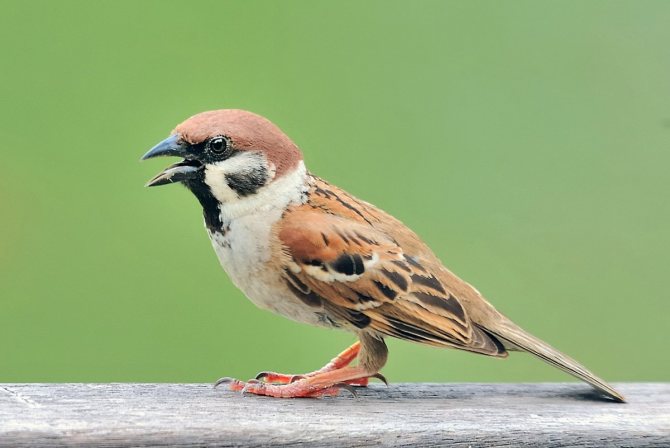

Field sparrow (lat.Passer montanus). <>
How to make a birdhouse out of 8mm plywood.
Important: For the birdhouse, you can take unpolished waterproof plywood. Water resistance means there is no need to process the walls of the birdhouse additionally. If you have sanded plywood, make notches on it.
The process of making a birdhouse from this material is standard:
- Make a drawing of the parts with a simple pencil and a square.
- Cut out the parts with a hacksaw or jigsaw.
- For the taphole, drill a hole so that the jigsaw file fits into it. Then cut out the notch in a circle. You can drill the tap hole with a file.
- Sand the saw cut lines with sandpaper.
- Mark places for self-tapping screws, drill holes.
- First, assemble the front wall of the house by attaching a perch to it.
- Then connect the walls together.
- Finally, attach the bottom and roof.
- Nail a long block to the back wall for further installation of the birdhouse.
Direct benefit
The author once set himself the goal of calculating: what is the economic efficiency of a birdhouse on a plot of 6 acres "for myself"? Labor costs accounted for the bulk of the cost of the bird house; the cost of working time was 200 rubles per hour, which corresponds to a decent salary of 32,000 rubles at that time. Taking this into account, the birdhouse and 2 titmouses cost about 1000 rubles.
4 years later, while the birds were living, it turned out that only the savings on the purchase of vegetables, fruits and plant protection products, compared to the same period without the involvement of birds, amounted to ... about 28,000 rubles, or 7,000 rubles / year! That is, the birdhouses paid off 28 times, or 2800%. Wow profit!
How much you get depends, of course, on local conditions and on which birds will settle. But for sure, even without calculations, the direct benefit from attracting birds to the farm with the help of a birdhouse will be obvious.
How to make a birdhouse from a 5 liter plastic bottle.
Important: A plastic birdhouse is most often made for decorative purposes. Such a craft can be done with children, brightly decorate it so that it pleases the eye.
Reasons why birds will not settle in a plastic birdhouse:
- Birds will not settle and will not produce offspring, since the plastic is transparent and does not contribute to the emergence of a sense of protection.
- In a too colorful birdhouse, birds are also unlikely to settle, in order to protect themselves from predators. And the variegated will attract cats, forty.
- Plastic does not allow air to pass through and releases toxins in the sun.
If you want to make a decorative birdhouse, plastic will work. This material can be found in every home and is easy to work with. For a decorative birdhouse, bottles of different sizes are suitable, it all depends on your imagination.
All you need to do is cut out the entrance, decorate the birdhouse and hang it in a prominent place.
There are many decor options:
- You can paint the bottle and draw patterns, ornaments.
- Stick on beads, buttons.
- Decorate with thick yarn, colored rope.
It is better to make a feeder out of a plastic bottle, it will bring much more benefit.
Video: How to make a birdhouse from a plastic bottle?
Safety engineering
Working with wood requires adhering to safety rules. Making even the simplest birdhouse, you can injure yourself with a tool, drive a splinter into your finger. To prevent this from happening, remember the simple rules for joinery and carpentry:
- It is advisable to wear comfortable and non-marking overalls, hide your hair under a beret. Thin or linen gloves are required, they will protect you from splinters and significantly soften the blow if you or your young assistant are not yet very good at using a hammer and often fall on your fingers with a swing.
- If you have to saw and drill a lot, wear protective goggles to prevent small sawdust from getting into your eyes.
- Tools such as a knife, hacksaw, saw, planer must be well sharpened.
It is very easy to injure yourself with a blunt instrument, since it does not fix well in the wood and constantly strives to slip off.
- All power tools used in the work (screwdriver, drill, power saw or jigsaw) must be in good working order, without damage. Do not allow moisture, chips, and other contaminants to get onto electrical appliances.
When finishing work or even taking a short break, unplug the tool from the mains.
- Place cutting tools with the blade down.
You shouldn't cut the material by putting it on your knee, even if you saw it in an interesting movie and it looked cool. In reality, such manipulations often end in wounds, and not in beautiful birdhouses.
- The hammer should be comfortable, with a suitable weight and a sufficiently long handle. Think about the tool in your hand, try to hammer in a couple of nails with it, and if everything turned out easily and naturally, you can continue to work with it. Be sure to check that the working part is well attached to the handle.
- When hanging a finished birdhouse from a tree, be sure to use a ladder or stepladder. It is very good if you do this not alone, but in the company of friends, to insure each other.
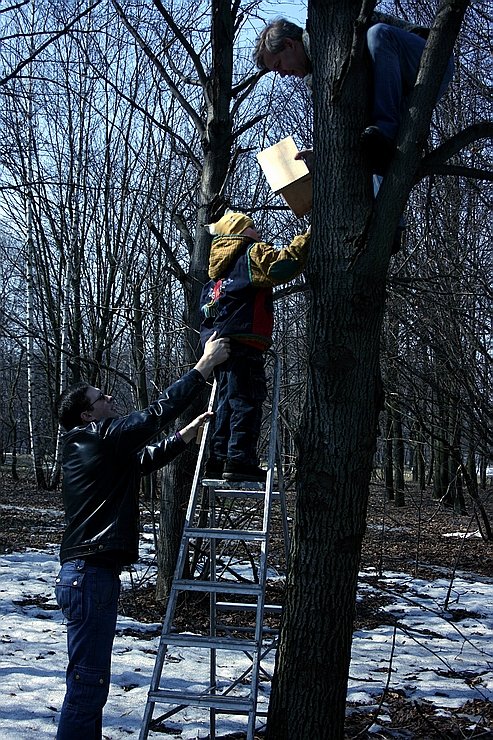

Set up a birdhouse with the whole company to hedge each other
How to make a birdhouse out of a cardboard shoe box.
As you already understood, birds are not stupid creatures. They choose a reliable home that will protect them from rain, cold, and predators. It is for this reason that a cardboard birdhouse should not be taken seriously, but as a decor - yes.
If you have a cardboard shoe box lying around, don't rush to throw it away. You can give her a second life by building a decorative house. Sizing is not important here, because birds will not settle here.
Step-by-step production of a birdhouse from a cardboard box:
- Cover the edges of the cardboard box with tape so that the edges do not fall apart over time;
- Mark the notch with a pencil;
- Cut it out with a clerical knife;
- Decorate the box;
- Attach it to a tree or under a roof.
It is quite possible that birds will choose your cardboard house as a feeder if you regularly put treats in the form of seeds and bread crumbs there.
Titmouse
Perhaps the most useful and only useful bird that does no harm is the great tit. It is almost exclusively an insectivorous bird that feeds mainly on fruit trees. Methodically examining every twig, every leaf, it destroys all pests living on the tree: adults, larvae, and eggs. The need for food in the tit is very high. She lays eggs twice a season, 7-12 eggs at a time. Chicks are very voracious, as they grow rapidly: in 2-3 days their weight doubles.
Parents have to work tirelessly to feed their offspring. During the day, they fly up to their nest with food about 400 times, destroying about 10 thousand insects during the feeding period, of which 30% are pests, including moth caterpillars. During the moth breeding season, sometimes whole flocks of tits appear in the gardens, flying from all the surroundings. As a result, the moth is almost completely exterminated. One pair of tits can clear about 40 apple trees from pests over the summer.
For the winter, tits do not fly away and continue their useful work, clearing the garden of wintering forms of pests, for example, pecking on the eggs of the ringed silkworm, caterpillars of the golden-tail, etc. The great tit is a forest bird that has not yet forgotten its forest skills. She prefers to nest in her natural habitats - in forests. She flies to the gardens only to feed.
Fruit trees with their thin crown, poorly protecting the nest from bad weather, do not seem to her as a reliable refuge. But if you hang a titmouse in your garden, then it is possible that the titmouse will settle in it. In autumn, tits leave their nests, unite in nomadic flocks and fly closer to human habitation in the hope of finding food.
The blue tit, which got its name from the blue cap, has a short beak, like strong tweezers. It is very convenient for them to peck small insect eggs from the branches, to tear off the scale insects that have adhered to the bark.
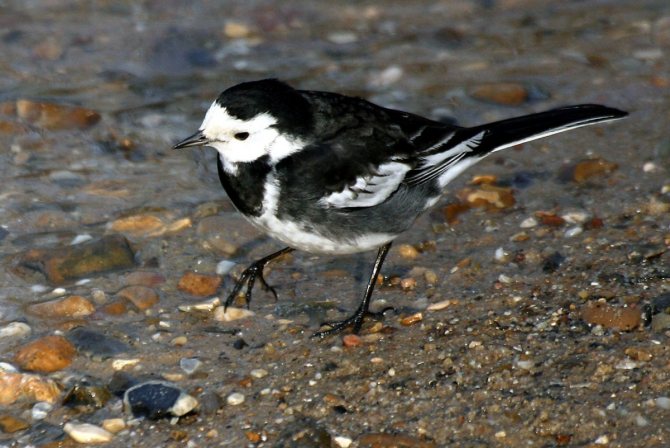

White wagtail (lat.Motacilla alba).
How to make a birdhouse from a juice or milk bag.
Very quickly and easily, you can make an analogue of a birdhouse from a bag in which there was juice or milk. To do this, you will need an empty juice or milk bag, scissors, rope or wire for fastening.
Step by step production:
- Cut two holes in the box. Two holes are made so that the bird can fly away quickly if it is in danger.
- Make small holes for the rope or wire, and pass the rope through.
- Secure the treehouse.
If you apply diligence and turn on your imagination, you can make a bright, colorful, original house. Ideas in the photo below.
Parking
It is necessary to attach the nesting so as not to damage the trees. You can tie the house to a tree with a tarred hemp rope, soft wire, or an electric cord. To do this, wire the trunk of a tree with a wire, pass the ends through the loops of nails driven into the upper part of the house, and tie it over the roof. When the nest is lowered, the wire loop will stretch out and firmly press the lid against the body of the house.
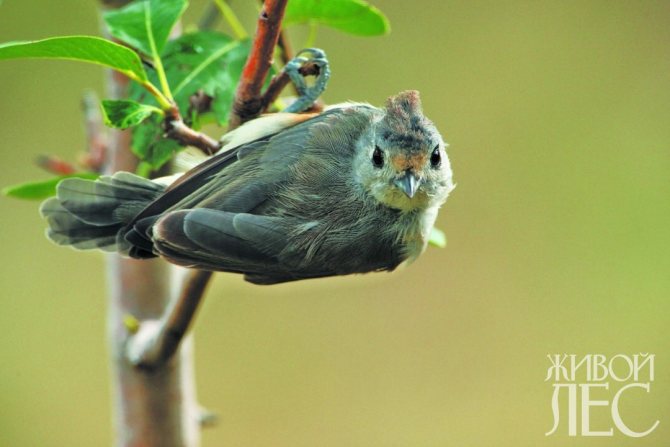

If you need to attract birds to young orchards, you can put nests on poles 3-4 m high. The poles are stuck in the ground near a tree and tied to the trunk with a rope.
How to make a birdhouse from wine corks.
Wine corks are a good material for making a birdhouse. Due to their density, they allow the house to remain dry even in the rain, and also serve as additional insulation.
Crafting tips:
- The easiest way is to stick the corks on the finished birdhouse using hot glue, which also serve as an original decor.
- It is undesirable to hammer the corks with nails into the birdhouse - the sharp ends of the nails can injure the birds.
You can make a decorative birdhouse. For this you will need:
- Traffic jams;
- Hot glue;
- Cardboard.
Step by step production:
- Hot glue the plugs together. Take an equal number of plugs on each side of the house;
- Leave room for a taphole in your design;
- To make the roof, glue the corks onto the cardboard;
- Attach the roof to the house;
- Decorate the birdhouse as you like.
Nest in the house
In or near human habitation, gray flycatchers, redstart-coots, white wagtails nest. These are small birds, and for their nests it is not difficult for them to find a variety of shelters in human buildings: cracks in the boarding, gaps in the masonry, a rasp of firewood. Their nests were even found in mailboxes, in an old samovar pipe, in a felt boot, forgotten on the fence.
They willingly settle in unoccupied titmouses. All this speaks to the need for birds to make their nests in well-protected, sheltered places. Under natural conditions, these birds make their nests in tree hollows.
How to protect a birdhouse from cats, squirrels, magpies.
- Experienced people advise placing birdhouses away from trees, on poles.
- The birdhouse should be located at a height of 4.5 m.
- A tin collar attached to a pole can serve as protection from cats.
- You can also make an obstacle in the form of a barbed wire roller on the pole.
- The design of the birdhouse should be correct: a long canopy will not allow a magpie, squirrel or cat to stick their head in the entrance.
- The perch in front of the entrance should not be made too long, otherwise the predator will easily settle down on it.
- The diameter of the tap hole should be no more than 5 cm, it should be located almost at the roof. A large canopy thus protects the penetration of the predator into the house.
Can a birdhouse be painted with gouache?
If you want birds to settle in your birdhouse, do not paint or decorate it with colorful decorations. Feathered friends do not care about beauty; for them, protection comes first. A bright birdhouse will attract cats.
The decorative birdhouse is primarily for beauty. Therefore, when creating it, it is appropriate to use both all kinds of decorations and paint.
For coloring, you can use acrylic paints, gouache, linseed oil paints. Gouache is very convenient to use as it dries quickly.
In order for the gouache paint to lay flat on the surface, a certain sequence must be observed:
- First, sand the surface to be painted with sandpaper.
- Then apply the base - white acrylic paint. Wait until it dries completely.
- The next stage is drawing a sketch of the picture and painting with gouache.
- Wait until the gouache is completely dry, and then open the drawing with varnish.
- It is advisable to apply varnish a couple of times.
If you don't know how to draw, you can use stencils. Simply transfer the prepared templates to the birdhouse with a pencil, and then paint with a brush.
What can you draw on a birdhouse? Everything that your fantasy tells you - birds, flowers, patterns, butterflies, grass and trees, abstract patterns. There is no limit to perfection. You can see examples of drawings on birdhouses below in the photo.
How to make do-it-yourself birdhouse decoupage.
Even a beginner can handle a simple decorating of a birdhouse using decoupage technique, if desired.
Tools and materials:
- Harvesting a birdhouse;
- Napkins for decoupage;
- Scissors, decoupage glue;
- Brushes, acrylic paint;
- Varnish;
- Sandpaper.
Step-by-step master class:
- Sand the nesting box to keep it free from roughness.
- Then wipe with a damp cloth to remove dust.
- Apply a coat of paint, base.If necessary, apply a couple of coats for more thorough staining.
- Wait for the paint to dry completely.
- Now, from decoupage napkins, cut rectangles for the sides of the birdhouse of the appropriate size.
- Stick the blanks.
- Now it remains to stick the cut elements on the facade of the birdhouse. In this case, it is a gnome, mushrooms, a ladybug and an inscription. You can choose whatever you like.
- At the final stage, it remains to open the birdhouse with varnish to protect it from moisture and dry it. Now the birdhouse is ready to delight passers-by with its elegant look.
Birdhouse ideas using decoupage technique.
Video: Decoupage of a birdhouse.
DIY ideas for unusual and beautiful birdhouses.
You can find original birdhouses, so unusual that you will not immediately understand that this is a house for birds. In the form of animals, with multi-colored stones, painted, in a rustic style.
Summer residents decorate their plots with birdhouses to the delight of themselves and their neighbors, but they decorate parks no less actively. You can find whole towns of birdhouses.
We have compiled a selection of original birdhouses for your inspiration.
International Bird Day is celebrated on April 1. Let's give the feathered houses for housewarming.
Content:
- 1 The little secret of the big tit
- 2 Bird flats
- 3 Wagtail
- 4 Taste and color ...
- 5 Secrets and subtleties of the birdhouse
- 6 How to build a birdhouse. Blueprints
- 7 We hang the birdhouse
- 8 Taking care of the house
- 9 Starlings in a birdhouse
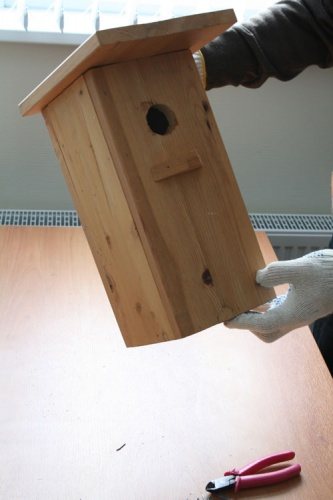

We invite you to help the birds by building cozy houses for them. If the birds settle near you, it will be more convenient to watch them, in the garden they will save plants from insect pests. And in summer, the most careful observers will be able to see the first emergence of chicks from the nest.
Whenever birds settle in a house you built, you feel proudly that someone else needs it. It turns out - you do not live in vain!


